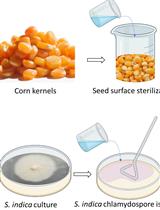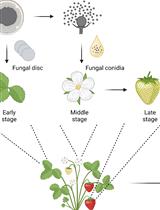- EN - English
- CN - 中文
Quantification of the Humidity Effect on HR by Ion Leakage Assay
离子渗漏实验定量分析湿度对超敏反应的影响
发布: 2019年04月05日第9卷第7期 DOI: 10.21769/BioProtoc.3203 浏览次数: 6021
评审: Zhibing LaiHedwin Kitdorlang DkharAnonymous reviewer(s)
Abstract
We describe a protocol to measure the contribution of humidity on cell death during the effector-triggered immunity (ETI), the plant immune response triggered by the recognition of pathogen effectors by plant resistance genes. This protocol quantifies tissue cell death by measuring ion leakage due to loss of membrane integrity during the hypersensitive response (HR), the ETI-associated cell death. The method is simple and short enough to handle many biological replicates, which improves the power of test of statistical significance. The protocol is easily applicable to other environmental cues, such as light and temperature, or treatment with chemicals.
Keywords: ETI (ETI)Background
Environmental cues are important factors in determining the outcome of host-pathogen interactions. The disease triangle paradigm requires, among all, a favorable environment for disease to develop (Francl, 2001; Scholthof, 2007). High humidity, for example, represses HR development and negatively regulates ETI (Zhou et al., 2004; Xin et al., 2016; Mwimba et al., 2018). It is, thus, important to quantify the effect of environments on host-pathogen interactions.
Cell death by HR during ETI is often quantified using a time-course measurement of ion leakage from infected tissue to the aqueous solution surrounding the tissues (Hatsugai and Katagiri, 2018). However, when interested in assessing the contribution of the environment to the HR development, it is necessary for tissue to remain in the environment being studied until HR has developed.
In this protocol, we subject infected tissue to 50% RH or 90% RH for 36 h before conductivity is measured. Also, we have adjusted the dosage of the pathogen to OD600nm = 0.002 to delay the onset of HR and maximize the effect of the environment on HR development. The method adapted here was originally designed to measure cell death in senescing leaves (Woo et al., 2001). Leaves were immersed in 400 mM mannitol, and conductivity was expressed as percentage of the ratio of conductivity measurement before and after boiling. In this modified method, we use tissue of equal size (leaf disc), which make reporting percent ion leakage optional. This protocol was used in our study (Mwimba et al., 2018) and can be applied to other environmental cues or to chemical treatments.
Materials and Reagents
- 200 µl and 1,000 µl pipet tips
- 1.5 ml tube (Eppendorf, catalog number: 022363204)
- 15 ml sterilized tubes (VWR, catalog number: 89039-664)
- 50 ml sterilized tubes (VWR, catalog number: 89039-656)
- 1 ml needle-less syringes for bacterial inoculation (BD, catalog number: 309659)
- Kimwipes (Kimberly-Clarck, catalog number: 34120)
- Pseudomonas syringae pv. tomato DC3000 expressing the AvrRpt2 effector (Pst AvrRpt2)
- dH2O
- MgCl2 (Sigma, catalog number: M8266) or MgSO4 (Sigma, catalog number: M7506)
- Mannitol (Sigma, catalog number: M4125)
- Agar A (Bio Basic, catalog number: FB0010)
- Proteose peptone (BD Biosciences, catalog number: 211684)
- K2HPO4·3H2O (Fisher scientific, CAS: 16788-57-1)
- 1 M MgSO4 (VWR, catalog number: 0338-500G)
- 80% Glycerol (Sigma, catalog number: G5516)
- King’s B agar (see Recipes) plate with kanamycin (50 µg/ml) and rifampicin (25 µg/ml) antibiotic selection
- 400 mM mannitol solution (see Recipes)
Equipment
- 1 L beaker
- Shaker (Lab Companion, SI-600R)
- Water bath (Precision Scientific, Model 25)
- Growth chambers (Percival, AR36L3)
- Pipets (Eppendorf, 20-200 µl and 100-1,000 µl)
- Spectrophotometer (Amersham Biosciences, model: Ultraspec 2100 pro)
- Electro-conductivity meter (Thermo Scientific, model: Orion Star A322)
- Puncher and sampling tool (Electron Microscopy Sciences, model: EMS Rapid-core 6.0, catalog number: 69039-60)
Software
- Microsoft Excel
- Graph prism, or R
Procedure
文章信息
版权信息
© 2019 The Authors; exclusive licensee Bio-protocol LLC.
如何引用
Mwimba, M. and Dong, X. (2019). Quantification of the Humidity Effect on HR by Ion Leakage Assay. Bio-protocol 9(7): e3203. DOI: 10.21769/BioProtoc.3203.
分类
植物科学 > 植物生理学 > 生物胁迫
发育生物学 > 细胞信号传导 > 胁迫反应
生物化学 > 其它化合物 > 离子
您对这篇实验方法有问题吗?
在此处发布您的问题,我们将邀请本文作者来回答。同时,我们会将您的问题发布到Bio-protocol Exchange,以便寻求社区成员的帮助。
Share
Bluesky
X
Copy link












